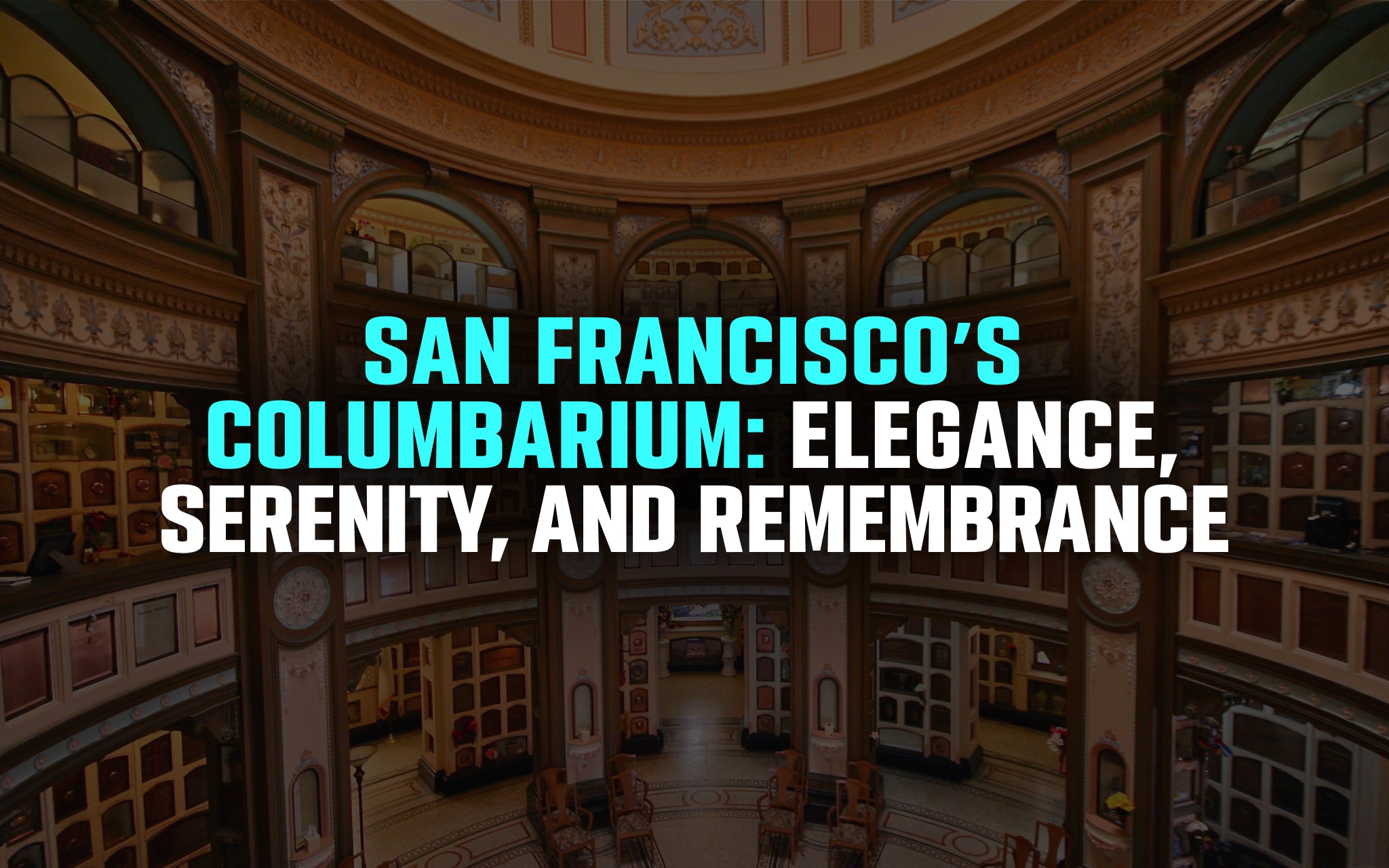
The Columbarium in San Francisco is a sacred space where history, art, and memory converge. Built in 1898 as a resting place for cremated remains, it transcends its purpose to become a masterpiece of architectural grace. Its grand façade, adorned with intricate carvings and timeless detailing, draws visitors into a realm of quiet reflection. Inside, light filters through luminous stained-glass windows, painting the air with shifting hues that evoke both serenity and reverence. This is not merely a memorial—it is a sanctuary where the beauty of life’s impermanence is celebrated in every detail.
As you explore the Columbarium, you’ll notice its seamless blend of classical and modern architectural elements. The domed ceilings, adorned with elaborate patterns, highlight the meticulous attention to detail that defines this space. Its circular layout not only enhances the acoustics but also allows visitors to feel immersed in its tranquil environment, making it a memorable destination.
Every corner of the Columbarium reflects artistry and intention, from the delicate ironwork on its gates to the inscriptions on individual niches. It is a space where history meets artistry, providing a visually stunning yet deeply meaningful setting for remembrance and reflection.
The Columbarium’s History and Legacy
Originally constructed in 1898 by architect Bernard J.S. Cahill, the Columbarium has stood as a beacon of dignity and remembrance in San Francisco. Over the decades, it has become a cherished symbol of the city’s cultural fabric, serving as a resting place for generations of families. Its enduring presence tells the story of a community bound by heritage and respect for those who came before.
The Columbarium faced challenges during the mid-20th century when cremation lost popularity and the structure fell into disrepair. However, it was lovingly restored by the Neptune Society, ensuring its preservation for future generations. This transformation has allowed the Columbarium to once again become a vital part of San Francisco’s cultural and historical landscape.
Today, the Columbarium stands as a testament to resilience and reverence. Its carefully maintained interior and thoughtful memorials make it a place of beauty and peace, inviting visitors to connect with the past while contemplating their own stories.
A Sanctuary for Memories and Meaning
The Columbarium is more than a resting place; it is a sanctuary for memories, offering visitors a chance to connect deeply with the past. Every niche holds not just the remains of an individual but the essence of their life, marked by keepsakes, photographs, and heartfelt inscriptions. Walking through its hallowed halls, visitors are struck by the sense of intimacy and humanity that the Columbarium embodies.
For families, the Columbarium serves as a sacred space to honor loved ones and ensure their stories are preserved. Its tranquil environment provides a setting where personal grief can be met with healing and where remembrance takes on a profound and tangible form. The act of placing mementos within its niches is a deeply meaningful ritual that underscores the importance of legacy and memory.
The Columbarium also reminds visitors of the timeless nature of life’s cycles. Its enduring architecture and thoughtfully curated spaces invite contemplation, offering solace and a sense of continuity. Whether visiting to pay respects or simply to admire its beauty, the Columbarium inspires reflection and reinforces the value of treasuring both life’s fleeting moments and its lasting impressions.
A Serene Visit: What to Expect
A visit to the Columbarium is a unique and contemplative experience, offering much more than a glimpse into its architectural beauty. Guests are welcomed to explore its quiet halls and marvel at the stories preserved in its niches. Guided tours provide deeper insight into the history of the site, while self-guided visits allow for personal reflection and discovery.
Inside, visitors will find an array of niches decorated with personal mementos, flowers, and photographs, each one telling its own story. The Columbarium is not just a resting place; it is a gallery of lives lived, filled with memories that resonate through time. Visitors often find inspiration in these tributes, feeling a deep connection to the individuals commemorated within its walls.
For those interested in genealogy, the Columbarium offers an opportunity to trace family histories and uncover connections to San Francisco’s past. It is a space where personal discovery meets historical exploration, providing a fulfilling and enriching experience for all who visit.
The Columbarium’s Location and Accessibility
Situated in the vibrant city of San Francisco, the Columbarium is easily accessible, making it a convenient and rewarding destination for locals and tourists alike. It is located in the Richmond District, a neighborhood known for its quiet charm and proximity to Golden Gate Park. This location offers visitors the chance to explore a tranquil oasis within the bustling city.
Public transportation options, including buses and light rail, make reaching the Columbarium straightforward, while ample parking ensures accessibility for those driving. Its central location also places it near several notable attractions, allowing visitors to create a full day of exploration.
Nearby landmarks such as the Legion of Honor and the Presidio provide additional cultural and historical experiences. The Columbarium serves as a serene counterpoint to these bustling sites, offering a moment of reflection amid a day of adventure in San Francisco.
Exploring the Museum of 3D Illusions
While the Columbarium offers a serene journey into history, San Francisco also boasts dynamic attractions like the Museum of 3D Illusions. This lively museum provides an entirely different experience, filled with interactive exhibits that transport visitors into fantastical worlds. From standing on a mountain’s edge to floating on balloons, the Museum allows guests to step into vibrant and immersive scenes that spark imagination and creativity.
The Museum’s Smash It! experience adds a unique twist, inviting visitors to channel their emotions in a fun and cathartic way. Decorate a plate with personal messages or designs, then break it to release stress and embrace joy. This activity is a favorite for those seeking an unconventional yet deeply satisfying way to unwind.
Together, the Museum of 3D Illusions and the Columbarium highlight the diversity of experiences San Francisco offers. One offers a chance for reflection, while the other ignites creativity, showcasing the city’s ability to cater to a range of interests and emotions.
Preserving History and Culture in San Francisco
The Columbarium stands as a vital reminder of the importance of preserving history and honoring those who shaped the city’s past. Its meticulously maintained structure and carefully curated spaces ensure that the memories it holds will endure for generations. In a city known for its innovation, the Columbarium provides a grounding connection to San Francisco’s roots.
As visitors move between the tranquility of the Columbarium and the vibrant energy of attractions like the Museum of 3D Illusions, they experience the city’s dynamic character. This balance between reflection and recreation is what makes San Francisco truly special.
Through its commitment to preserving spaces like the Columbarium, San Francisco continues to celebrate its rich heritage while embracing modernity. It is a city where history and innovation coexist, offering visitors a profound and multifaceted experience.
FAQ
2. Can I visit both the Columbarium and the Museum of 3D Illusions in one day?
Yes, both are located in San Francisco, offering unique experiences. While the Columbarium provides a serene and reflective setting, the Museum of 3D Illusions delivers an interactive and creative adventure, making them an intriguing pair of destinations to explore.
3. What makes the Columbarium special compared to other sites in San Francisco?
The Columbarium is renowned for its rich history, artistic design, and tranquil environment. It stands out as a place of reverence and beauty, contrasting with San Francisco’s lively urban attractions, creating a uniquely meaningful experience.


